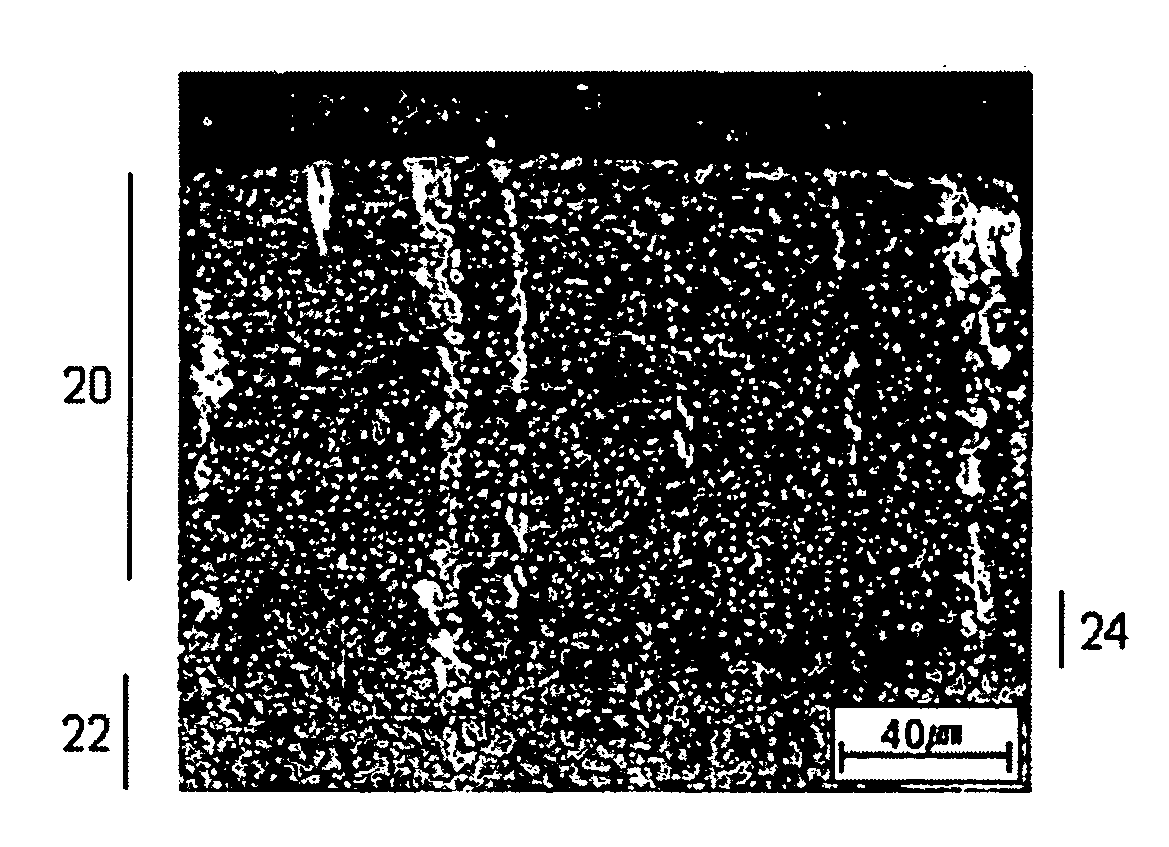Process for diffusing titanium and nitride into a steel or steel alloy by altering the content of such
- Summary
- Abstract
- Description
- Claims
- Application Information
AI Technical Summary
Benefits of technology
Problems solved by technology
Method used
Image
Examples
example 1
[0025]FIG. 1 illustrates a steel article treated with the titanium and nitride diffusion process as described in U.S. Pat. No. 6,645,566. The pretreated steel generally includes about 0.9% vanadium and about 12% chromium. Steels having this composition are generally referred in the art as D2 type steels.
[0026]The steel article is soaked in a moderately heated non-electrolyzed salt bath is used which contains activated-electrolyzed metallic titanium. Sodium dioxide and a salt selected from the group consisting of sodium cyanate and potassium cyanate, in amounts of from about 80 to about 85 w / w %, is present in the salt bath with from about 15 to about 20 w / w % of NaCO2, NaCO3, Na2CO3, or sodium chloride. To the bath is added from about 2 to about 20 micrograms of electrolyzed metallic titanium. The steel article is soaked in the bath for from about 6 hours at from about 430° C. to about 670° C. The electrolyzed titanium catalyzes the diffusion of the titanium and nitride from the bat...
example 2
[0028]FIG. 2 illustrates a steel article treated with the titanium and nitride diffusion process in accordance with an aspect of the present invention. The content of the steel article is altered such that there is an increase in vanadium content to about 1.95% vanadium, while also limiting the chromium content to about 4.1% chromium. Steels having this composition are generally known in the art as M2 type steels. Although M2 type steels are described in U.S. Pat. No. 6,645,566, it is shown herein that increasing the vanadium content in the steel or steel alloy increases the effectiveness of the process. It is further shown in this embodiment that limiting the chromium content in the steel or steel alloy also increases the effectiveness of the process. It is to be noted that M3 and higher grade high speed steels generally contain a higher vanadium content and a lower chromium content than M2 type steels.
[0029]The altered steel article is treated under similar conditions as the proce...
example 3
[0033]FIG. 3 illustrates a steel article treated with the titanium and nitride diffusion process in accordance with an aspect of the present invention. The content of the steel article is altered such that there is an increase in vanadium content to about 4% vanadium, while also limiting the chromium content to about 4% chromium. Steels having this composition are generally known in the art as M4 type steels.
[0034]The altered steel article is treated under similar conditions as the process described in Examples 1 and 2. More specifically, the altered steel article is soaked in a moderately heated non-electrolyzed salt bath is used which contains activated-electrolyzed metallic titanium. Sodium dioxide and a salt selected from the group consisting of sodium cyanate and potassium cyanate, in amounts of from about 80 to about 85 w / w %, is present in the salt bath with from about 15 to about 20 w / w % of NaCO2, NaCO3, Na2CO3, or sodium chloride. To the bath is added from about 2 to about...
PUM
| Property | Measurement | Unit |
|---|---|---|
| Temperature | aaaaa | aaaaa |
| Temperature | aaaaa | aaaaa |
| Fraction | aaaaa | aaaaa |
Abstract
Description
Claims
Application Information
 Login to View More
Login to View More - R&D
- Intellectual Property
- Life Sciences
- Materials
- Tech Scout
- Unparalleled Data Quality
- Higher Quality Content
- 60% Fewer Hallucinations
Browse by: Latest US Patents, China's latest patents, Technical Efficacy Thesaurus, Application Domain, Technology Topic, Popular Technical Reports.
© 2025 PatSnap. All rights reserved.Legal|Privacy policy|Modern Slavery Act Transparency Statement|Sitemap|About US| Contact US: help@patsnap.com


